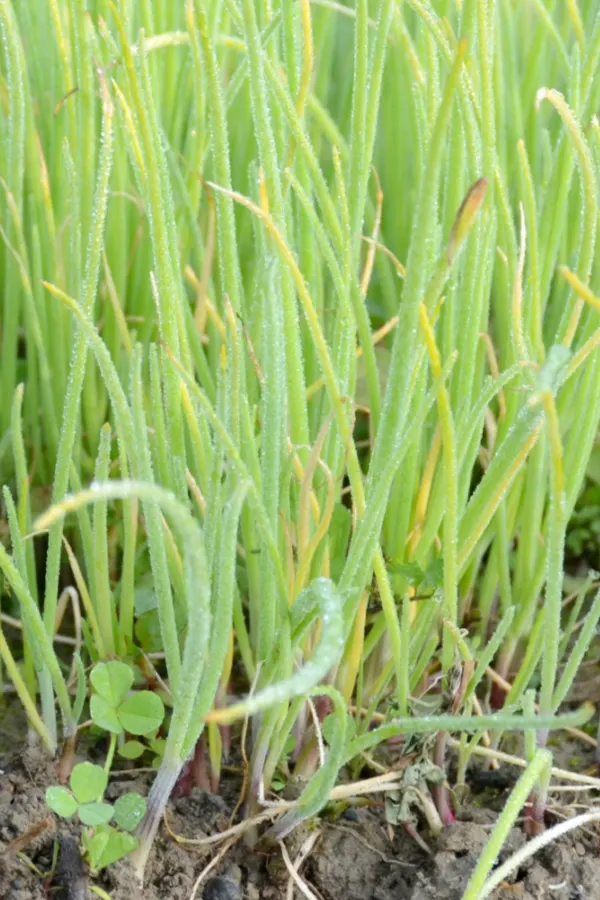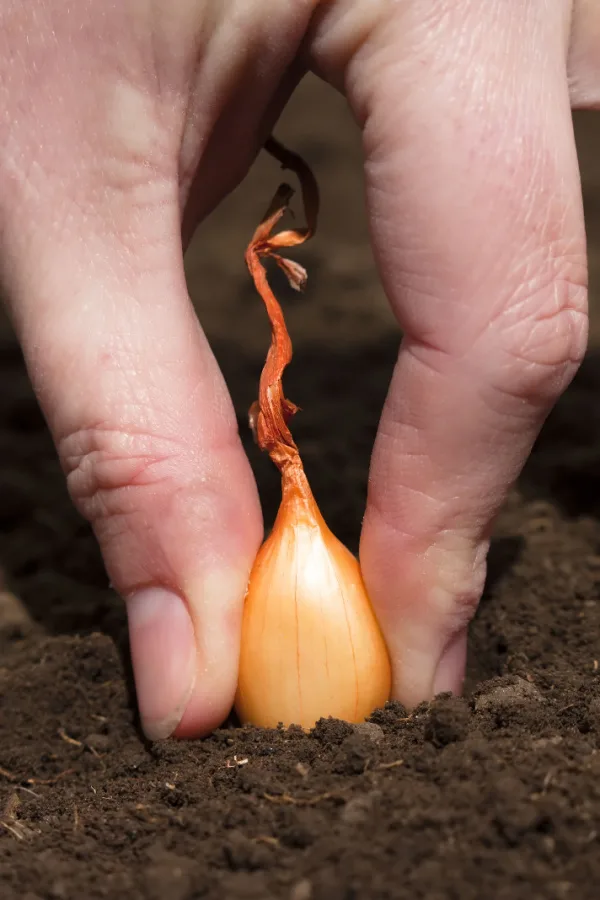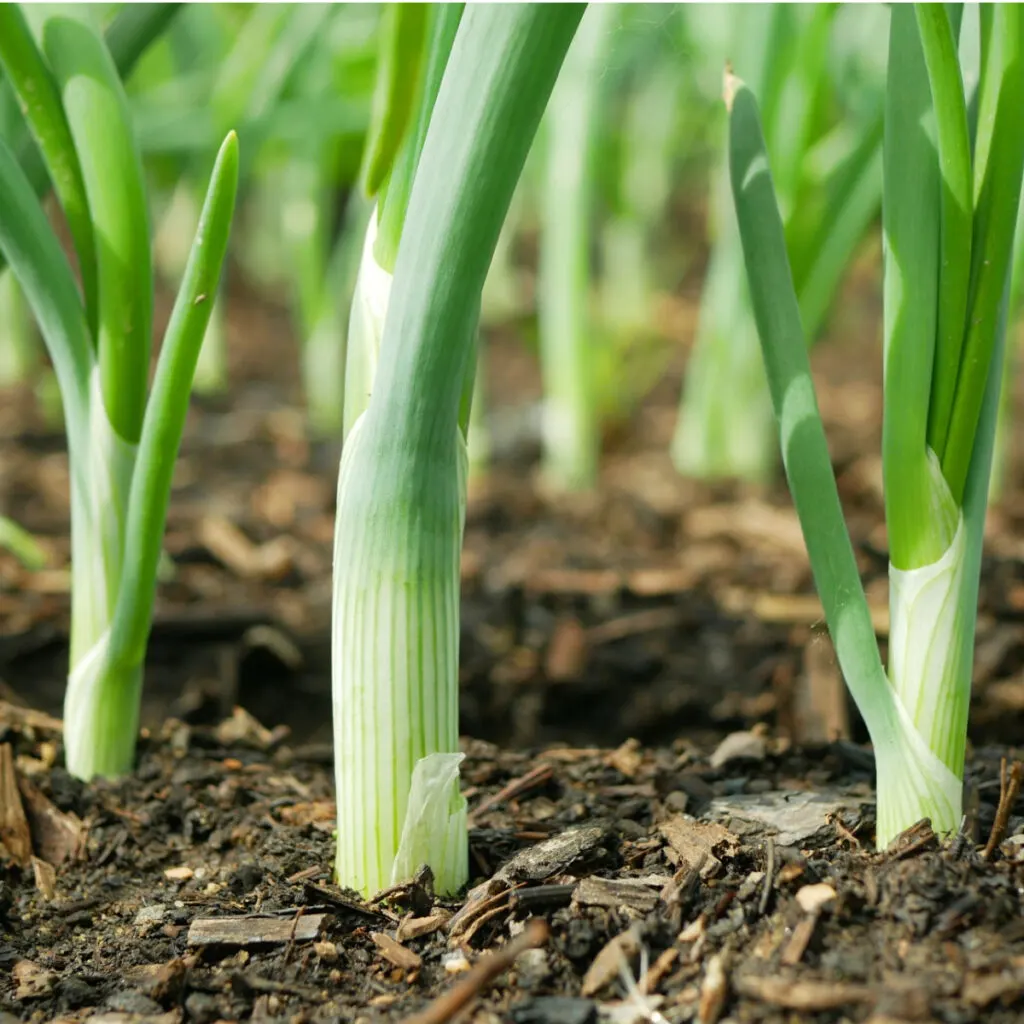If you want to have a great harvest this summer of sizable onions – then one thing is for sure, you need to plant onion sets this spring instead of seeds or transplants!
Onions can be planted and grown using three different planting methods. The first is by planting seeds. The second is to plant small seedlings, often called transplants. And the third is by planting sets. All 3 methods certainly have a time and place where they can be effective, but when it comes to planting onions in the spring for a big summer harvest, sets are the way to go.
Growing from seed is certainly one of the most economical ways of all to grow onions. But it does have a few drawbacks. Especially for planting early in the growing season. Onion seeds take a long time to develop and mature. In fact, many onion varieties can take as long as 5 to 6 months to develop large bulbs.

Because of that, for most climates, a frost or freeze usually occurs before onions growing from seed can ever reach full size. That means a harvest of smaller onions that just never quite get to their full, robust flavor. And even if you start with seedlings or transplants, they don’t have enough time to develop either.
Onion sets, however, give you a great head start at full growth potential! Sets are basically small, immature onions that have been grown from seed. Once the onions reach a small size, they are then harvested and kept to grow as sets.
Why You Should Be Planting Onion Sets In The Spring
Because sets have already aged a bit in the growing process, once they go back in the ground, they mature much more quickly than seeds. In fact, instead of the 5 to 6 months it can take an onion seed to develop, onions sets can be harvested in as little as 60 to 80 days as mature onions. And even sooner if you want a few smaller spring onions.
But crop speed and size are not the only reason planting with sets is a better choice than seeds. In addition to growing faster and developing more flavor – onion sets are also far easier to maintain.
Onion seeds and sprouts are tiny. When they first sprout and grow, they can be almost impossible to see. And when weeds start to grow up with the tiny seedlings, it can make keeping your beds clear incredibly tough.

Anyone who has ever weeded tiny onions seed sprouts knows exactly how hard the task can be. For one, it can be hard to pull the weeds without yanking up the tiny onion sprouts. And if you don’t weed, they can take over the crop quickly and snuff it out.
Onion sets, on the other hand, are far easier to manage. Not only do they germinate fast, they also have much larger sprouting stalks. This makes them far easier to distinguish as onions. Even better, they also can compete against young weeds seeds much more successfully.
Now that we have covered the “why” of using sets, we will cover how to best plant them for big success!
Selecting The Best Variety – Planting Onions Sets
First and foremost, you need to select what type of onions you want to grow and get your sets early. Onion sets can usually be found at local nurseries, greenhouses, and on line, but they usually go pretty quick.

When selecting your bulbs, smaller bulbs are better than large bulbs for planting. If onion set bulbs are overly large, they can easily bolt before they mature. Look for sets whose bulbs are about 3/4 of an inch in diameter, or the size of a nickel. Affiliate Onion Set Link: 3 Colors Mix Onion Sets (Starter Bulbs) Yellow, Red, White Sweet Onions
Nearly all onion sets are sold as either yellow, white or red onions. There are a lot of varieties within each color of bulb, but in general, the flavors can best be described as follows:
Yellow Onions – Yellow onions are the workhorse of the three and are the most common. They have a good balance of flavor and hold up well in all kinds of dishes or for fresh eating.
White Onions – White onions tend to be a bit more crisp, with a stronger flavor than yellow. They are one of the best choices for salsa. They hold up to cooking quite well.
Red Onions – The mere color profile of red onions makes them perfect for using in salads, salsas and more. They can be a bit strong for some, especially if allowed to age. They make an excellent young onion too as their flavor tends to be crisp and still sweet.
How To Plant Spring Onion Sets
Onions grow best in fertile, loose and well draining soil. As a root crop, the more loose the soil is, the easier they will grow and develop. Good drainage is vital as well. It keeps the bulbs from sitting in overly wet soil and rotting out.

A little bit of prep work to the soil prior to planting will go a long way toward success. Start by working in a fair amount of compost to the soil in the planting row. We like to create a small trench a few inches deep, and then fill it up halfway full with compost.
Next, we plant our onion set bulbs down in the compost so that the bulbs are about 1.5″ deep from the surface of the soil. This gives the onions plenty of good organic matter around their roots to power the bulbs. We then water the bulbs and cover them with the remaining soil.
If you have exceptionally hard or clay-like soil, you can also add sand to the soil mix. This will help improve drainage and promote better bulb growth. This is only necessary if you have extremely tough or hard soil.
Spacing – How To Plant Spring Onion Sets
When it comes to spacing bulbs, how you space when planting all depends on how you want to harvest your crop. Onions can be harvested early as smaller spring onions – or left in the ground to mature to full size.
For spring onions, we like to plant each bulb about 1″ apart. Since we are always harvesting them earlier as smaller produce, they don’t require as much room to grow. In fact, we start harvesting our spring onions as little as 4 weeks after planting. Not only are they delicious, it’s nice to have a bit of fresh produce so early in the growing season!
For onions we want to grow to full size, we allow 3 to 4 inches between each bulb at planting time. This gives each bulb plenty of space to mature and grow into full size onions. Once you have your onions in the ground, it’s time to mulch them as quickly as you can!
Mulching, Watering & Fertilizing – How To Plant Spring Onion Sets
Mulch plants with a thin layer of straw or shredded leaves after planting. It’s important to do this right on the day you plant. This will not only help conserve moisture, but help to keep weeds out.
It is important to keep the initial mulching a bit thin to help the bulbs sprout faster. Once the bulbs have sprouted through the surface, mulch to a depth of 3 to 4 inches to help snuff out competing weeds even more.
As for watering, onions will not require a lot of additional watering unless you experience long periods of drought. You will want to water every few days the first few weeks after planting if no rain falls as it will help the sprouting process. After that, as long as they receive a bit of rain every week, they should be fine.
Onions will not require much in the way of additional nutrients beyond the compost in the soil. They are low feeders, and too many nutrients will actually cause them to bolt early. As long as you have a bit of compost in the planting hole and average soil, you should be good to go!
Here is to planting and growing your own onion sets this year! Happy Gardening- Jim and Mary.
Jim and Mary Competti have been writing gardening, DIY and recipe articles and books for over 15 years from their 46 acre Ohio farm. The two are frequent speakers on all things gardening and love to travel in their spare time.
As always, feel free to email us at thefarm@owgarden.com with comments, questions, or to simply say hello! You can sign up for our free email list in the subscribe now box in the middle of this article. Follow us on Facebook here : OWG Facebook. This article may contain affiliate links.

